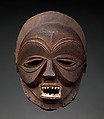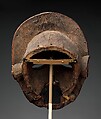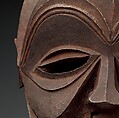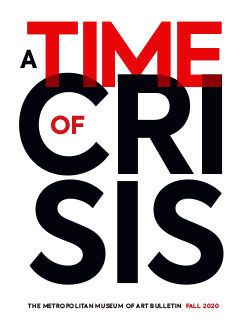Sachihongo Mask
Not on view
Mbunda-style Sachihongo masks are characterized by their round shape, proportionally exaggerated features, and prominent brow ridge and cheeks. All the examples that survive date from no earlier than the late nineteenth through twentieth centuries and most have been entirely stripped of their costume elements. The sculptors responsible for these works were heavily influenced by neighboring Chokwe artists renowned for their play back and forth between realistic and bombastic exaggeration of different elements of the human physiognomy. This exceptional example is striking for its scale and the dramatic graphic emphasis given to the articulation of essential facial features. At the mid-point horizontal semi-circular voids denote the ocular apertures. These are emphatically framed by a series of concentric linear arcs. A series of three successive curves extend from the bridge of the nose to the temples defining the brows directly below a convex volumetric forehead. Directly below either eye successive arcs define pouches under each of these and the cheekbones. Centrally positioned is the raised ridge of the nose with flaring nostrils above a projecting rectilinear mouth. The open mouth features an upper row of individually defined teeth and a lower row that is less articulated.
An array of makishi masquerades are performed at the end of initiation rites for young boys, or mukanda, celebrated by the Vaka Chiyama Cha Mukwamayi community of the Luvale, Chokwe, Luchazi and Mbunda peoples of Zambia. During a period of seclusion adolescent boys undergo circumcision and are instructed in qualities they are expected to take on as adult men. This mask form, known as Sachihongo, is the only wood variety featured at the culmination of the celebration when the youth are brought back to the community. Although the practice was likely established far earlier, masked dances of the Mbunda were recorded by European observers beginning in the 1870s. In 2005 this performative tradition was added to the UNESCO list of Intangible Cultural Heritage.
Sachihongo most commonly represents the spirit of a cultural archetype — an ancestral hunter armed with a bow. The elevated status of the subject is such that it may also be addressed as an ancestral chief or diviner. A male dancer would have worn the mask along with a knit fiber costume, a skirt of palm leaves, and other accessories, including anklets. Equipped with a bow and arrow, and carrying a flywhisk or ceremonial axe, Sachihongo dances to a rapid tempo.
Alisa LaGamma, 2016
Due to rights restrictions, this image cannot be enlarged, viewed at full screen, or downloaded.
This artwork is meant to be viewed from right to left. Scroll left to view more.














